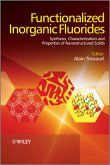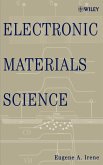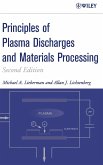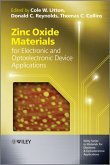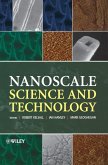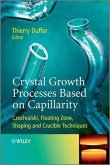Atomic Layer Deposition of Nanostructured Materials
Ed. by Nicola Pinna and Mato Knez
Atomic Layer Deposition of Nanostructured Materials
Ed. by Nicola Pinna and Mato Knez
- Gebundenes Buch
- Merkliste
- Auf die Merkliste
- Bewerten Bewerten
- Teilen
- Produkt teilen
- Produkterinnerung
- Produkterinnerung
Clearly structured, the introductory part of this first book on ALD provides a great insight into all aspects of the technique and processes, while the second part focuses on various aspects of nanomaterials and fields of application.
Atomic layer deposition, formerly called atomic layer epitaxy, was developed in the 1970s to meet the needs of producing high-quality, large-area fl at displays with perfect structure and process controllability. Nowadays, creating nanomaterials and producing nanostructures with structural perfection is an important goal for many applications in…mehr
Andere Kunden interessierten sich auch für
![Functionalized Inorganic Fluorides Functionalized Inorganic Fluorides]() Functionalized Inorganic Fluorides211,99 €
Functionalized Inorganic Fluorides211,99 €![Electronic Materials Science Electronic Materials Science]() Eugene A. IreneElectronic Materials Science196,99 €
Eugene A. IreneElectronic Materials Science196,99 €![Principles of Plasma Discharges and Materials Processing Principles of Plasma Discharges and Materials Processing]() Michael A. LiebermanPrinciples of Plasma Discharges and Materials Processing208,99 €
Michael A. LiebermanPrinciples of Plasma Discharges and Materials Processing208,99 €![Zinc Oxide Materials for Electronic and Optoelectronic Device Applications Zinc Oxide Materials for Electronic and Optoelectronic Device Applications]() Zinc Oxide Materials for Electronic and Optoelectronic Device Applications271,99 €
Zinc Oxide Materials for Electronic and Optoelectronic Device Applications271,99 €![Nanoscale Science and Technology Nanoscale Science and Technology]() Nanoscale Science and Technology116,99 €
Nanoscale Science and Technology116,99 €![Crystal Growth Processes Based on Capillarity Crystal Growth Processes Based on Capillarity]() Thierry Duffar (Hrsg.)Crystal Growth Processes Based on Capillarity284,99 €
Thierry Duffar (Hrsg.)Crystal Growth Processes Based on Capillarity284,99 €![Negative-Refraction Metamaterials Negative-Refraction Metamaterials]() G V EleftheriadesNegative-Refraction Metamaterials145,99 €
G V EleftheriadesNegative-Refraction Metamaterials145,99 €-
-
-
Clearly structured, the introductory part of this first book on ALD provides a great insight into all aspects of the technique and processes, while the second part focuses on various aspects of nanomaterials and fields of application.
Atomic layer deposition, formerly called atomic layer epitaxy, was developed in the 1970s to meet the needs of producing high-quality, large-area fl at displays with perfect structure and process controllability. Nowadays, creating nanomaterials and producing nanostructures with structural perfection is an important goal for many applications in nanotechnology. As ALD is one of the important techniques which offers good control over the surface structures created, it is more and more in the focus of scientists. The book is structured in such a way to fi t both the need of the expert reader (due to the systematic presentation of the results at the forefront of the technique and their applications) and the ones of students and newcomers to the fi eld (through the first part detailing the basic aspects of the technique).
This book is a must-have for all Materials Scientists, Surface Chemists, Physicists, and Scientists in the Semiconductor Industry.
Atomic layer deposition, formerly called atomic layer epitaxy, was developed in the 1970s to meet the needs of producing high-quality, large-area fl at displays with perfect structure and process controllability. Nowadays, creating nanomaterials and producing nanostructures with structural perfection is an important goal for many applications in nanotechnology. As ALD is one of the important techniques which offers good control over the surface structures created, it is more and more in the focus of scientists. The book is structured in such a way to fi t both the need of the expert reader (due to the systematic presentation of the results at the forefront of the technique and their applications) and the ones of students and newcomers to the fi eld (through the first part detailing the basic aspects of the technique).
This book is a must-have for all Materials Scientists, Surface Chemists, Physicists, and Scientists in the Semiconductor Industry.
Produktdetails
- Produktdetails
- Verlag: Wiley-VCH
- Artikelnr. des Verlages: 1132797 000
- 1. Auflage
- Erscheinungstermin: 23. November 2011
- Englisch
- Abmessung: 254mm x 182mm x 28mm
- Gewicht: 1027g
- ISBN-13: 9783527327973
- ISBN-10: 3527327975
- Artikelnr.: 33463366
- Verlag: Wiley-VCH
- Artikelnr. des Verlages: 1132797 000
- 1. Auflage
- Erscheinungstermin: 23. November 2011
- Englisch
- Abmessung: 254mm x 182mm x 28mm
- Gewicht: 1027g
- ISBN-13: 9783527327973
- ISBN-10: 3527327975
- Artikelnr.: 33463366
Nicola Pinna studied physical chemistry at the Université Pierre et Marie Curie (Paris). He received his PhD in 2001, and in 2002, he moved to the Fritz Haber Institute of the Max Planck Society (Berlin). In 2003, he joined the Max Planck Institute of Colloids and Interfaces (Potsdam). In 2005, he moved to the Martin Luther University, Halle-Wittenberg, as an Assistant Professor of Inorganic Chemistry. Since 2006 he is researcher at the Department of Chemistry and CICECO of the University of Aveiro and since 2009 he is also Assistant Professor at the School of Chemical and Biological Engineering of the Seoul National University. In 2011 he was ranked among the top 100 materials scientists of the past decade by impact. His research activity is focused on the development of novel routes to nanostructured materials, their characterization, and the study of their physical properties. Mato Knez studied chemistry at the University of Ulm in Germany. He did his dissertation at the Max Planck Institute of solid state research in Stuttgart from 2000-2003. In 2003 he joined the Max Planck Institute for Microstructure Physics in Halle as a Postdoc where he established the ALD-based research direction. Since 2006 he is leading a research group funded by the German Ministry of Education and Research (BMBF). In January 2012 he will join CIC nanoGUNE in San Sebastian (Spain) as an Ikerbasque Research Professor. His research activities are mainly focused on various aspects of the application of ALD, including the synthesis of optical nanolaminates, infi ltration mechanisms when ALD is applied to soft materials, and ALD-assisted nanofabrication of photonic and plasmonic structures. Aside from ALD he has strong research activites in biotemplated inorganic nanostructures for applications in nanotechnology and medicine.
PART I: Introduction to ALD THEORETICAL MODELING OF ALD PROCESSES
Introduction Overview of Atomistic Simulations Calculation of Properties
Using Quantum Simulations Prediction of ALD Chemical Mechanisms Example of
a Calculated ALD Mechanism: ALD of Al2O3 Using TMA and Water STEP COVERAGE
IN ALD Introduction Growth Techniques Step Coverage Models in ALD
Experimental Verifications of Step Coverage Models Summary PRECURSORS FOR
ALD PROCESSES Introduction General Requirements for ALD Precursors Metallic
Precursors for ALD Nonmetal Precursors for ALD Conclusions SOL-GEL CHEMSTRY
AND ATOMIC LAYER DEPOSITION Aqueous and Nonaqueous Sol-Gel in Solution
Sol-Gel and ALD: An Overview Mechanistic and In Situ Studies MOLECULAR
LAYER DEPOSITION OF HYBRID ORGANIC-INORGANIC FILMS Introduction General
Issues for MLD of Hybrid Organic-Inorganic Films MLD Using
Trimethylaluminum and Ethylene Glycol in an AB Process Expansion to an ABC
Process Using Heterobifunctional and Ring-Opening Precursors Use of a
Homotrifunctional Precursor to Promote Cross-Linking in an AB Process MLD
of Hybrid Alumina-Siloxane Films Using an ABCD Process Future Prospects for
MLD of Hybrid Organic-Inorganic Films¿ LOW-TEMPERATURE ATOMIC LAYER
DEPOSITION Introduction Challenges of LT-ALD Materials and Processes Toward
Novel LT-ALD Processes Thin Film Gas Diffusion Barriers Encapsulation of
Organic Electronics Conclusions PLASMA ATOMIC LAYER DEPOSITION Introduction
Plasma Basics Plasma ALD Configurations Merits of Plasma ALD Challenges for
Plasma ALD Concluding Remarks and Outlook PART II: Nanostructures by ALD
ATOMIC LAYER DEPOSITION FOR MICROELECTRONIC APPLICATIONS Introduction ALD
Layers for Memory Devices ALD for Logic Devices Concluding Remarks
NANOPATTERNING BY AREA-SELECTIVE ATOMIC LAYER DEPOSITION Concept of
Area-Selective Atomic Layer Deposition Change of Surface Properties
Patterning Applications of AS-ALD Current Challenges COATINGS ON HIGH
ASPECT RATIO STRUCTURES Introduction Models and Analysis Characterization
Methods for ALD Coatings in High Aspect Ratio Structures Examples of ALD in
High Aspect Ratio Structures Nonideal Behavior during ALD in High Aspect
Ratios Conclusions and Future Outlook COATINGS OF NANOPARTICLES AND
NANOWIRES ALD on Nanoparticles Vapor-Liquid-Solid Growth of Nanowires by
ALD Atomic Layer Epitaxy on Nanowires ALD on Semiconductor NWs for Surface
Passivation ALD-Assisted Formation of Nanopeapods Photocorrosion of
Semiconductor Nanowires Capped by ALD Shell Interface Reaction of Nanowires
with ALD Shell ALD ZnO on NWs/Tubes as Seed Layer for Growth of Hyperbranch
Conclusions ATOMIC LAYER DEPOSITION ON SOFT MATERIALS Introduction ALD on
Polymers for Passivation, Encapsulation, and Surface Modification ALD for
Bulk Modification of Natural and Synthetic Polymers and Molecules ALD for
Polymer Sacrificial Templating: Membranes, Fibers, and Biological and
Optical Structures ALD Nucleation of Patterned and Planar SAMs and Surface
Oligomers Reactions during Al2O3 ALD on Representative Polymer Materials
Summary APPLICATION OF ALD TO BIOMATERIALS AND BIOCOMPATIBLE COATINGS
Application of ALD to Biomaterials Biocompatible Coatings Summary COATING
OF CARBON NANOTUBES Introduction Purification and Surface Functionalization
of Carbon Nanotubes Decoration/Coating of Carbon Nanotubes by Solution
Routes Decoration/Coating of Carbon Nanotubes by Gas-Phase Techniques
Atomic Layer Deposition on Carbon Nanotubes Coating of Large Quantity of
CNTs by ALD ALD Coating of Other sp2-Bonded Carbon Materials Conclusions
INVERSE OPAL PHOTONICS Introduction and Background Properties of
Three-Dimensional Photonic Band Structures Large-Pore and Non-Close-Packed
Inverse Opals Experimental Studies Tunable PC Structures Summary
NANOLAMINATES Introduction Optical Applications Thin Film Encapsulation
Applications in Electronics Copper Electroplating Applications Solid Oxide
Fuel Cells Complex Nanostructures Summary CHALLENGES IN ATOMIC LAYER
DEPOSITION Introduction Metals Nonmetal Elements Binary Compounds Ternary
and Quaternary Compounds Nucleation Conclusions General Introduction to ALD
and New Challenges Theroretical Modeling of ALD Processes New Chemical
Approaches to ALD Polymer and Hybrid ALD (MLD) Low Temperature ALD
Processes PART 2: NANOSTRUCTURES BY ATOMIC LAYER DEPOSITION ALD in
Microelectronics Patterning and Linear Structures Coating of High Aspect
Ratio Structures Coatings of Nanoparticles Coatings of Soft Materials
Coatings of Carbon Nanotubes Inverse Opals and Photonics Optical
Nanolaminates ALS on Biological Materials
Introduction Overview of Atomistic Simulations Calculation of Properties
Using Quantum Simulations Prediction of ALD Chemical Mechanisms Example of
a Calculated ALD Mechanism: ALD of Al2O3 Using TMA and Water STEP COVERAGE
IN ALD Introduction Growth Techniques Step Coverage Models in ALD
Experimental Verifications of Step Coverage Models Summary PRECURSORS FOR
ALD PROCESSES Introduction General Requirements for ALD Precursors Metallic
Precursors for ALD Nonmetal Precursors for ALD Conclusions SOL-GEL CHEMSTRY
AND ATOMIC LAYER DEPOSITION Aqueous and Nonaqueous Sol-Gel in Solution
Sol-Gel and ALD: An Overview Mechanistic and In Situ Studies MOLECULAR
LAYER DEPOSITION OF HYBRID ORGANIC-INORGANIC FILMS Introduction General
Issues for MLD of Hybrid Organic-Inorganic Films MLD Using
Trimethylaluminum and Ethylene Glycol in an AB Process Expansion to an ABC
Process Using Heterobifunctional and Ring-Opening Precursors Use of a
Homotrifunctional Precursor to Promote Cross-Linking in an AB Process MLD
of Hybrid Alumina-Siloxane Films Using an ABCD Process Future Prospects for
MLD of Hybrid Organic-Inorganic Films¿ LOW-TEMPERATURE ATOMIC LAYER
DEPOSITION Introduction Challenges of LT-ALD Materials and Processes Toward
Novel LT-ALD Processes Thin Film Gas Diffusion Barriers Encapsulation of
Organic Electronics Conclusions PLASMA ATOMIC LAYER DEPOSITION Introduction
Plasma Basics Plasma ALD Configurations Merits of Plasma ALD Challenges for
Plasma ALD Concluding Remarks and Outlook PART II: Nanostructures by ALD
ATOMIC LAYER DEPOSITION FOR MICROELECTRONIC APPLICATIONS Introduction ALD
Layers for Memory Devices ALD for Logic Devices Concluding Remarks
NANOPATTERNING BY AREA-SELECTIVE ATOMIC LAYER DEPOSITION Concept of
Area-Selective Atomic Layer Deposition Change of Surface Properties
Patterning Applications of AS-ALD Current Challenges COATINGS ON HIGH
ASPECT RATIO STRUCTURES Introduction Models and Analysis Characterization
Methods for ALD Coatings in High Aspect Ratio Structures Examples of ALD in
High Aspect Ratio Structures Nonideal Behavior during ALD in High Aspect
Ratios Conclusions and Future Outlook COATINGS OF NANOPARTICLES AND
NANOWIRES ALD on Nanoparticles Vapor-Liquid-Solid Growth of Nanowires by
ALD Atomic Layer Epitaxy on Nanowires ALD on Semiconductor NWs for Surface
Passivation ALD-Assisted Formation of Nanopeapods Photocorrosion of
Semiconductor Nanowires Capped by ALD Shell Interface Reaction of Nanowires
with ALD Shell ALD ZnO on NWs/Tubes as Seed Layer for Growth of Hyperbranch
Conclusions ATOMIC LAYER DEPOSITION ON SOFT MATERIALS Introduction ALD on
Polymers for Passivation, Encapsulation, and Surface Modification ALD for
Bulk Modification of Natural and Synthetic Polymers and Molecules ALD for
Polymer Sacrificial Templating: Membranes, Fibers, and Biological and
Optical Structures ALD Nucleation of Patterned and Planar SAMs and Surface
Oligomers Reactions during Al2O3 ALD on Representative Polymer Materials
Summary APPLICATION OF ALD TO BIOMATERIALS AND BIOCOMPATIBLE COATINGS
Application of ALD to Biomaterials Biocompatible Coatings Summary COATING
OF CARBON NANOTUBES Introduction Purification and Surface Functionalization
of Carbon Nanotubes Decoration/Coating of Carbon Nanotubes by Solution
Routes Decoration/Coating of Carbon Nanotubes by Gas-Phase Techniques
Atomic Layer Deposition on Carbon Nanotubes Coating of Large Quantity of
CNTs by ALD ALD Coating of Other sp2-Bonded Carbon Materials Conclusions
INVERSE OPAL PHOTONICS Introduction and Background Properties of
Three-Dimensional Photonic Band Structures Large-Pore and Non-Close-Packed
Inverse Opals Experimental Studies Tunable PC Structures Summary
NANOLAMINATES Introduction Optical Applications Thin Film Encapsulation
Applications in Electronics Copper Electroplating Applications Solid Oxide
Fuel Cells Complex Nanostructures Summary CHALLENGES IN ATOMIC LAYER
DEPOSITION Introduction Metals Nonmetal Elements Binary Compounds Ternary
and Quaternary Compounds Nucleation Conclusions General Introduction to ALD
and New Challenges Theroretical Modeling of ALD Processes New Chemical
Approaches to ALD Polymer and Hybrid ALD (MLD) Low Temperature ALD
Processes PART 2: NANOSTRUCTURES BY ATOMIC LAYER DEPOSITION ALD in
Microelectronics Patterning and Linear Structures Coating of High Aspect
Ratio Structures Coatings of Nanoparticles Coatings of Soft Materials
Coatings of Carbon Nanotubes Inverse Opals and Photonics Optical
Nanolaminates ALS on Biological Materials
PART I: Introduction to ALD THEORETICAL MODELING OF ALD PROCESSES
Introduction Overview of Atomistic Simulations Calculation of Properties
Using Quantum Simulations Prediction of ALD Chemical Mechanisms Example of
a Calculated ALD Mechanism: ALD of Al2O3 Using TMA and Water STEP COVERAGE
IN ALD Introduction Growth Techniques Step Coverage Models in ALD
Experimental Verifications of Step Coverage Models Summary PRECURSORS FOR
ALD PROCESSES Introduction General Requirements for ALD Precursors Metallic
Precursors for ALD Nonmetal Precursors for ALD Conclusions SOL-GEL CHEMSTRY
AND ATOMIC LAYER DEPOSITION Aqueous and Nonaqueous Sol-Gel in Solution
Sol-Gel and ALD: An Overview Mechanistic and In Situ Studies MOLECULAR
LAYER DEPOSITION OF HYBRID ORGANIC-INORGANIC FILMS Introduction General
Issues for MLD of Hybrid Organic-Inorganic Films MLD Using
Trimethylaluminum and Ethylene Glycol in an AB Process Expansion to an ABC
Process Using Heterobifunctional and Ring-Opening Precursors Use of a
Homotrifunctional Precursor to Promote Cross-Linking in an AB Process MLD
of Hybrid Alumina-Siloxane Films Using an ABCD Process Future Prospects for
MLD of Hybrid Organic-Inorganic Films¿ LOW-TEMPERATURE ATOMIC LAYER
DEPOSITION Introduction Challenges of LT-ALD Materials and Processes Toward
Novel LT-ALD Processes Thin Film Gas Diffusion Barriers Encapsulation of
Organic Electronics Conclusions PLASMA ATOMIC LAYER DEPOSITION Introduction
Plasma Basics Plasma ALD Configurations Merits of Plasma ALD Challenges for
Plasma ALD Concluding Remarks and Outlook PART II: Nanostructures by ALD
ATOMIC LAYER DEPOSITION FOR MICROELECTRONIC APPLICATIONS Introduction ALD
Layers for Memory Devices ALD for Logic Devices Concluding Remarks
NANOPATTERNING BY AREA-SELECTIVE ATOMIC LAYER DEPOSITION Concept of
Area-Selective Atomic Layer Deposition Change of Surface Properties
Patterning Applications of AS-ALD Current Challenges COATINGS ON HIGH
ASPECT RATIO STRUCTURES Introduction Models and Analysis Characterization
Methods for ALD Coatings in High Aspect Ratio Structures Examples of ALD in
High Aspect Ratio Structures Nonideal Behavior during ALD in High Aspect
Ratios Conclusions and Future Outlook COATINGS OF NANOPARTICLES AND
NANOWIRES ALD on Nanoparticles Vapor-Liquid-Solid Growth of Nanowires by
ALD Atomic Layer Epitaxy on Nanowires ALD on Semiconductor NWs for Surface
Passivation ALD-Assisted Formation of Nanopeapods Photocorrosion of
Semiconductor Nanowires Capped by ALD Shell Interface Reaction of Nanowires
with ALD Shell ALD ZnO on NWs/Tubes as Seed Layer for Growth of Hyperbranch
Conclusions ATOMIC LAYER DEPOSITION ON SOFT MATERIALS Introduction ALD on
Polymers for Passivation, Encapsulation, and Surface Modification ALD for
Bulk Modification of Natural and Synthetic Polymers and Molecules ALD for
Polymer Sacrificial Templating: Membranes, Fibers, and Biological and
Optical Structures ALD Nucleation of Patterned and Planar SAMs and Surface
Oligomers Reactions during Al2O3 ALD on Representative Polymer Materials
Summary APPLICATION OF ALD TO BIOMATERIALS AND BIOCOMPATIBLE COATINGS
Application of ALD to Biomaterials Biocompatible Coatings Summary COATING
OF CARBON NANOTUBES Introduction Purification and Surface Functionalization
of Carbon Nanotubes Decoration/Coating of Carbon Nanotubes by Solution
Routes Decoration/Coating of Carbon Nanotubes by Gas-Phase Techniques
Atomic Layer Deposition on Carbon Nanotubes Coating of Large Quantity of
CNTs by ALD ALD Coating of Other sp2-Bonded Carbon Materials Conclusions
INVERSE OPAL PHOTONICS Introduction and Background Properties of
Three-Dimensional Photonic Band Structures Large-Pore and Non-Close-Packed
Inverse Opals Experimental Studies Tunable PC Structures Summary
NANOLAMINATES Introduction Optical Applications Thin Film Encapsulation
Applications in Electronics Copper Electroplating Applications Solid Oxide
Fuel Cells Complex Nanostructures Summary CHALLENGES IN ATOMIC LAYER
DEPOSITION Introduction Metals Nonmetal Elements Binary Compounds Ternary
and Quaternary Compounds Nucleation Conclusions General Introduction to ALD
and New Challenges Theroretical Modeling of ALD Processes New Chemical
Approaches to ALD Polymer and Hybrid ALD (MLD) Low Temperature ALD
Processes PART 2: NANOSTRUCTURES BY ATOMIC LAYER DEPOSITION ALD in
Microelectronics Patterning and Linear Structures Coating of High Aspect
Ratio Structures Coatings of Nanoparticles Coatings of Soft Materials
Coatings of Carbon Nanotubes Inverse Opals and Photonics Optical
Nanolaminates ALS on Biological Materials
Introduction Overview of Atomistic Simulations Calculation of Properties
Using Quantum Simulations Prediction of ALD Chemical Mechanisms Example of
a Calculated ALD Mechanism: ALD of Al2O3 Using TMA and Water STEP COVERAGE
IN ALD Introduction Growth Techniques Step Coverage Models in ALD
Experimental Verifications of Step Coverage Models Summary PRECURSORS FOR
ALD PROCESSES Introduction General Requirements for ALD Precursors Metallic
Precursors for ALD Nonmetal Precursors for ALD Conclusions SOL-GEL CHEMSTRY
AND ATOMIC LAYER DEPOSITION Aqueous and Nonaqueous Sol-Gel in Solution
Sol-Gel and ALD: An Overview Mechanistic and In Situ Studies MOLECULAR
LAYER DEPOSITION OF HYBRID ORGANIC-INORGANIC FILMS Introduction General
Issues for MLD of Hybrid Organic-Inorganic Films MLD Using
Trimethylaluminum and Ethylene Glycol in an AB Process Expansion to an ABC
Process Using Heterobifunctional and Ring-Opening Precursors Use of a
Homotrifunctional Precursor to Promote Cross-Linking in an AB Process MLD
of Hybrid Alumina-Siloxane Films Using an ABCD Process Future Prospects for
MLD of Hybrid Organic-Inorganic Films¿ LOW-TEMPERATURE ATOMIC LAYER
DEPOSITION Introduction Challenges of LT-ALD Materials and Processes Toward
Novel LT-ALD Processes Thin Film Gas Diffusion Barriers Encapsulation of
Organic Electronics Conclusions PLASMA ATOMIC LAYER DEPOSITION Introduction
Plasma Basics Plasma ALD Configurations Merits of Plasma ALD Challenges for
Plasma ALD Concluding Remarks and Outlook PART II: Nanostructures by ALD
ATOMIC LAYER DEPOSITION FOR MICROELECTRONIC APPLICATIONS Introduction ALD
Layers for Memory Devices ALD for Logic Devices Concluding Remarks
NANOPATTERNING BY AREA-SELECTIVE ATOMIC LAYER DEPOSITION Concept of
Area-Selective Atomic Layer Deposition Change of Surface Properties
Patterning Applications of AS-ALD Current Challenges COATINGS ON HIGH
ASPECT RATIO STRUCTURES Introduction Models and Analysis Characterization
Methods for ALD Coatings in High Aspect Ratio Structures Examples of ALD in
High Aspect Ratio Structures Nonideal Behavior during ALD in High Aspect
Ratios Conclusions and Future Outlook COATINGS OF NANOPARTICLES AND
NANOWIRES ALD on Nanoparticles Vapor-Liquid-Solid Growth of Nanowires by
ALD Atomic Layer Epitaxy on Nanowires ALD on Semiconductor NWs for Surface
Passivation ALD-Assisted Formation of Nanopeapods Photocorrosion of
Semiconductor Nanowires Capped by ALD Shell Interface Reaction of Nanowires
with ALD Shell ALD ZnO on NWs/Tubes as Seed Layer for Growth of Hyperbranch
Conclusions ATOMIC LAYER DEPOSITION ON SOFT MATERIALS Introduction ALD on
Polymers for Passivation, Encapsulation, and Surface Modification ALD for
Bulk Modification of Natural and Synthetic Polymers and Molecules ALD for
Polymer Sacrificial Templating: Membranes, Fibers, and Biological and
Optical Structures ALD Nucleation of Patterned and Planar SAMs and Surface
Oligomers Reactions during Al2O3 ALD on Representative Polymer Materials
Summary APPLICATION OF ALD TO BIOMATERIALS AND BIOCOMPATIBLE COATINGS
Application of ALD to Biomaterials Biocompatible Coatings Summary COATING
OF CARBON NANOTUBES Introduction Purification and Surface Functionalization
of Carbon Nanotubes Decoration/Coating of Carbon Nanotubes by Solution
Routes Decoration/Coating of Carbon Nanotubes by Gas-Phase Techniques
Atomic Layer Deposition on Carbon Nanotubes Coating of Large Quantity of
CNTs by ALD ALD Coating of Other sp2-Bonded Carbon Materials Conclusions
INVERSE OPAL PHOTONICS Introduction and Background Properties of
Three-Dimensional Photonic Band Structures Large-Pore and Non-Close-Packed
Inverse Opals Experimental Studies Tunable PC Structures Summary
NANOLAMINATES Introduction Optical Applications Thin Film Encapsulation
Applications in Electronics Copper Electroplating Applications Solid Oxide
Fuel Cells Complex Nanostructures Summary CHALLENGES IN ATOMIC LAYER
DEPOSITION Introduction Metals Nonmetal Elements Binary Compounds Ternary
and Quaternary Compounds Nucleation Conclusions General Introduction to ALD
and New Challenges Theroretical Modeling of ALD Processes New Chemical
Approaches to ALD Polymer and Hybrid ALD (MLD) Low Temperature ALD
Processes PART 2: NANOSTRUCTURES BY ATOMIC LAYER DEPOSITION ALD in
Microelectronics Patterning and Linear Structures Coating of High Aspect
Ratio Structures Coatings of Nanoparticles Coatings of Soft Materials
Coatings of Carbon Nanotubes Inverse Opals and Photonics Optical
Nanolaminates ALS on Biological Materials


